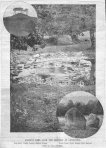
Photo used in EBT

Mr. Alfred Watkins, of the Watkins Meter Co., Hereford, sends me a delightfully illustrated little work (price 4s. 6d. net) under the above title, dealing chiefly with Herefordshire. Mr. Watkins is a Fellow and Progress Medallist (for 1910) of the Royal Photographic Society. The illustrations, some forty in number, are nearly all from his own photographs, and are given to illustrate what he claims is “a big discovery.” Very briefly stated, it seems to be that, long before the Romans made roads in this country, it was intersected by clearly “marked” British trackways. He gives scores of instances which he considers prove his discovery. He says: “It is necessary first to clear the mind of present ideas of roads from town to town, or with enclosed hedges, also of any assumption that orderly road planning was introduced by the Romans. Presume a primitive people, with few or no enclosures, wanting a few necessities (as salt, flint flakes, and, later on, metals), only to be had from a distance. The shortest way to such a distant point was a straight line; the human way of attaining a straight line is by sighting, and accordingly all these early trackways were straight, and laid out in much the same way that a marksman gets the back and fore sights of his rifle in line with the target.”
Mr. Watkins contends that the Britons had a trained corps of expert “sighters,” who used natural “marks” or made artificial ones to enable pedlars and merchants to track from place to place. His theory certainly lends additional interest to his references to barrows, tumps, ancient camps, moats, and other old landmarks, because it suggests a meaning and reason for what are often riddles. More than six hundred places, chiefly in Herefordshire, are mentioned in the Index; here are a few which bring back to me delightful angling days: Aymestry, Brampton Bryan, Bredwardine, Bromfield, Broom, Eardisland, Hereford, Kingsland, Leintwardine, Ledbury, Letton, Lucton, Ludlow, Lugg Bridge, Moccas, Monnow, Moreton-on-Lugg, Ross, Symond’s Yat, Tenbury, Wigmore. To a lover of lovely Herefordshire the little book will be a delight.
Source info: MS note by AW “April 8 1922”; checked in library.
Why this fishing magazine agreed to review an archaeology book is not clear. The magazine published the composite photo that was used for the title page of Early British Trackways, plus a caption (below) which does not appear in the book.